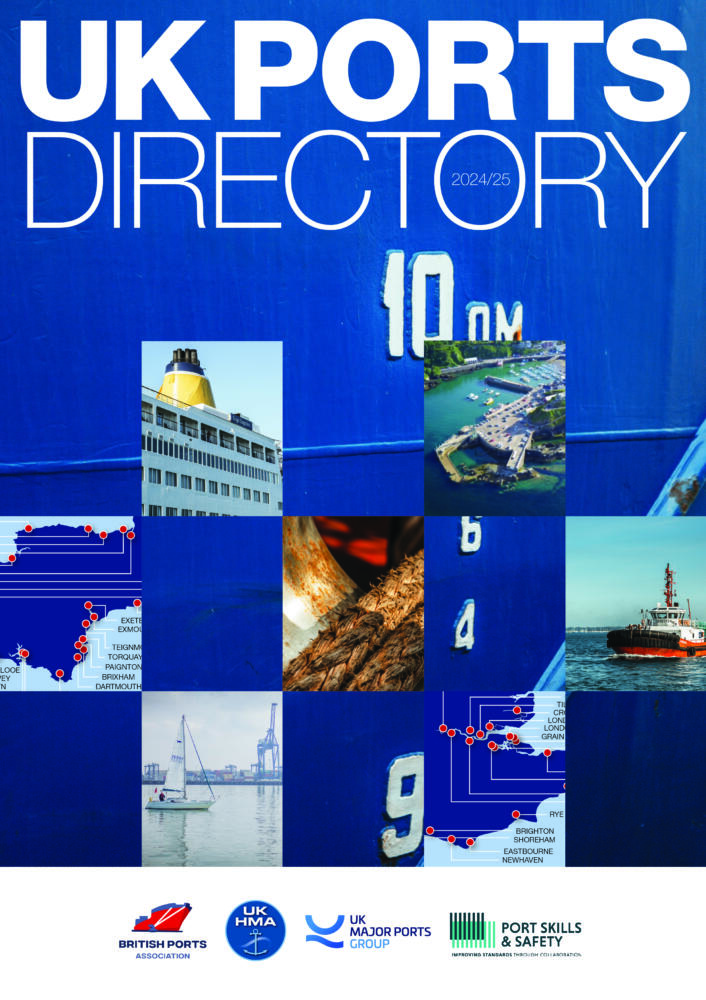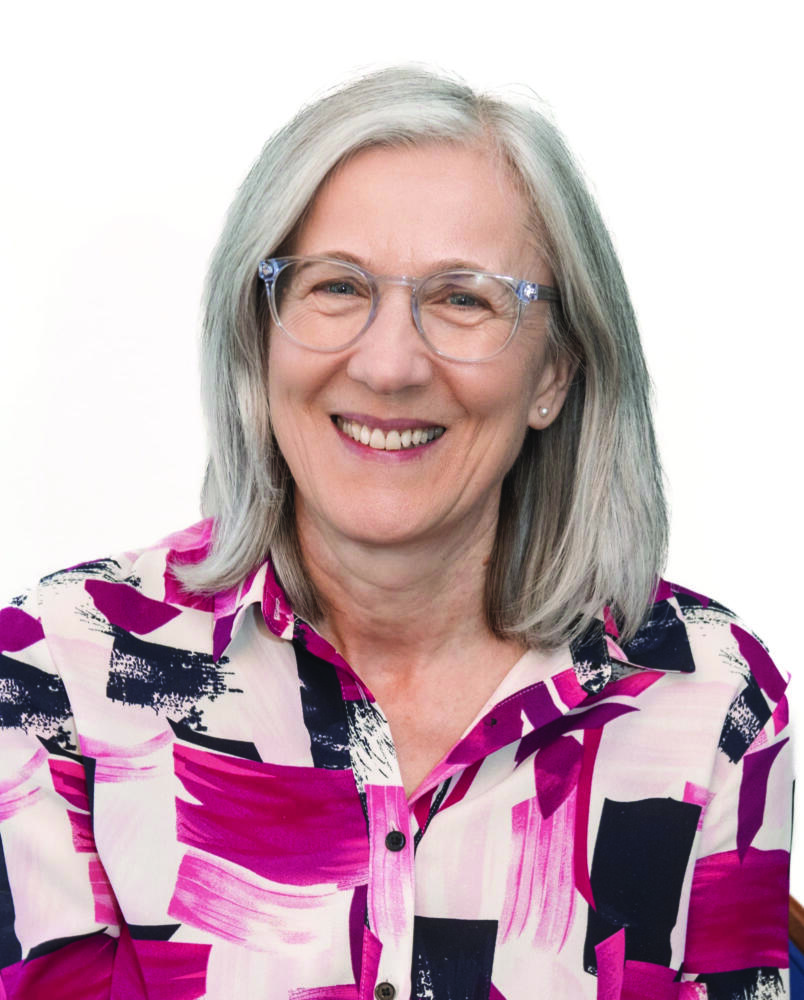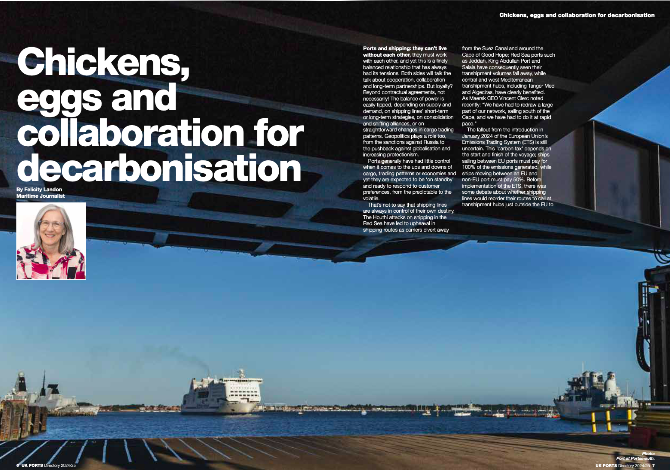Chickens, eggs and collaboration for decarbonisation
By Felicity Landon Maritime Journalist
Article from the new UK Ports Directory 2024/2025 published by Compass

Ports and shipping: they can’t live without each other, they must work with each other, and yet this is a finely balanced relationship that has always had its tensions. Both sides will talk the talk about cooperation, collaboration and long-term partnerships. But loyalty? Beyond contractual agreements, not necessarily! The balance of power is easily tipped, depending on supply and demand, on shipping lines’ short-term or long-term strategies, on consolidation and shifting alliances, or on straightforward changes in cargo trading patterns. Geopolitics plays a role too, from the sanctions against Russia to the pushback against globalisation and increasing protectionism.
Ports generally have had little control when it comes to the ups and downs of cargo, trading patterns or economies and yet they are expected to be ‘on standby’ and ready to respond to customer preferences, from the predictable to the volatile.
That’s not to say that shipping lines are always in control of their own destiny. The Houthi attacks on shipping in the Red Sea have led to upheaval in shipping routes as carriers divert away from the Suez Canal and around the Cape of Good Hope; Red Sea ports such as Jeddah, King Abdullah Port and Salala have consequently seen their transhipment volumes fall away, while central and west Mediterranean transhipment hubs, including Tanger Med and Algeciras, have clearly benefited. As Maersk CEO Vincent Clerc noted recently: “We have had to redraw a large part of our network, sailing south of the Cape, and we have had to do it at rapid pace.”
The fallout from the introduction in January 2024 of the European Union’s Emissions Trading System (ETS) is still uncertain. This ‘carbon tax’ depends on the start and finish of the voyage; ships sailing between EU ports must pay for 100% of the emissions generated, while ships moving between an EU and non-EU port must pay 50%. Before implementation of the ETS, there was some debate about whether shipping lines would reorder their routes to call at transhipment hubs just outside the EU to avoid the 100%levy, but then the European Commission announced that Tanger Med and East Port Said would be fully included in the ETS regime.
Since then, of course, ETS speculation has been overtaken by the Red Sea crisis, with Lloyd’s List Intelligence reporting that diverting away from the Suez Canal and around the Cape could cost up to US$1m per voyage in ETS costs for certain container ships, as faster speeds and longer distances nearly double CO2 emissions. Quite apart from the costs and upheaval, this significant diversion for major shipping lines means that emissions are rising just as the industry is seeking decarbonisation.
In May (2024), Sea-Intelligence highlighted a ETS loophole created by Brexit, in that UK port calls can count as the first/last port call before an EU port. “For example, if a vessel goes from New York to Antwerp, the carrier needs to report the emissions for 50% of the journey, as it goes from a non-EU port to an EU port. If the same carrier has a port call in Felixstowe in between New York and Antwerp, the carrier needs to pay zero ETS from New York to Felixstowe, and ETS of 50% of the very short journey from Felixstowe to Antwerp.” It remains to be seen whether Felixstowe will reap the benefits.
Back in the day, when 15,000 teu container ships were just being thought of, there was significant pressure
on major hub ports to invest heavily in the larger ship-to-shore cranes required to service them. Ports often had to make that investment leap of faith with little certainty of a shipping line’s long-term commitment for a return on investment. Today it is the same with offshore wind developers seeking suitable port/heavy lift/assembly facilities to support major construction projects.
Stephen Paterson, chief financial officer of Peterhead Port Authority, has highlighted the supply chain pressures and uncertainties when making investment decisions in support of offshore wind. “Ports are being asked for more services, deeper quays, deeper water and more land space but there are few guarantees and mostly agreements are fairly short-term,” he said.
Henrik Carstensen, CEO of the Danish Port of Grenaa, recently wrote: “It is a crucial prerequisite for an effective green transition in Denmark that we can trust each other across government, private wind suppliers and manufacturers, municipalities and the business community. We must have confidence in a proper framework for development and predictability in the agreements we enter into with each other.”
Automation and digitalisation are also areas where ports and shipping lines have to work together and establish a level of trust, with stakeholders willing to share information and access to real-time data. Smart containers will be able to talk to port systems to notify ETA at terminal gates, for example.
Decarbonisation, however, is probably the biggest ‘chicken-and-egg’ issue occupying both sides – shipping and ports – right now, and it’s the issue where collaboration is genuinely required. A shipowner considering investing millions of dollars in methanol-ready or ammonia-ready newbuilds needs to be confident that the fuel will be available. Will a port invest in storage/bunkering for a whole range of alternative fuels without certainty that someone will buy them?
Some are stepping forward – the Port of Bilbao, for example, is taking the risk and helping customers and logistics to decarbonise, said Andima Ormaetxe, Bilbao’s director for operations, commercial, logistics and strategy. Bilbao is leading the way on a green corridors project for the Atlantic Corridor, aiming to attract increasing volumes between Spain and the North of Europe – not only logistics volumes but also energy volumes based on Bilbao’s Strategic Energy Hub, evolving from fossil fuels to renewable sources, including the creation and supply of green hydrogen.
“We are taking the risk, investing in these processes and inviting shipping lines and shippers to start this trip of decarbonisation,” said Ormaetxe. “So we are really putting the egg before the chicken. If we just put pressure on the rest of the community, we are not going to succeed.”
Green corridors are springing up and/or being proposed as a solution to provide certainty on both sides. But even this is not necessarily straightforward. Speaking at Coastlink 2024 in Amsterdam, Jesper Christensen, operations director at DFDS, outlined the plans for a green corridor linking the Dover with Calais and Dunkirk. While an electric vessel can be built in a couple of years if the plan and design is ready, one of the key difficulties, he noted, is electrification of the ports. “We need a lot of electricity to run the vessels, and especially on the UK side it is not geared up for this.”
Doug Bannister, chief executive of the Port of Dover, has previously highlighted the obstacles faced by the UK port in the development of the proposed high-volume green corridor linking Dover, Calais and Dunkirk. “There is an option here that all the ferries are electric. The problem is, we don’t have much power,” he said. “Predicted demand would be 160MW. Right now, we have access to 8MW. They (ferry operators) are not going to invest in electric ferries unless there is power in the port, and we are not going to invest in electricity in the port unless there are electric ferries.”
Future fuel decisions are especially difficult where (many) ports are short of space. Also at Coastlink 2024, Johan-Paul Verschuure, director of Rebel Ports & Logistics, said: “In a lot of ports, port area will be very
sparse. If you import the same amount of energy via ammonia or hydrogen, it will need much more port space for the same energy. There will be more squeeze on existing terminals.”
And it’s not all or nothing. Patrick Walison, senior consultant for maritime strategy and economics at Royal HaskoningDHV, pointed out: “There will be a transition where you have to do both (traditional and future fuels), and that will create tension in spatial planning. Offshore wind needs more space. Working with ammonia or methanol means all kinds of safety rules and space issues as well. And alongside this there is the complexity of investment decisions and backing.”
Ports must ensure they have the right technical capabilities in place, considering project distance, expertise and experience and port cost, he said. “Also, ports have to make sure they don’t have stranded assets in two years’ time.”
There is general consensus that decarbonisation in shipping and ports will depend on more incentives and more regulation to drive forward developments. Investors need more certainty. Shippers don’t want to pay more, even if they do say they want to be green. Perhaps the arrival of the Corporate Sustainability Reporting Directive will focus minds more clearly on carbon footprints across the piece

